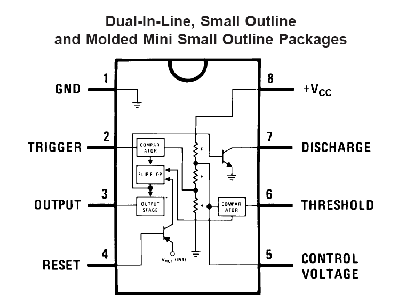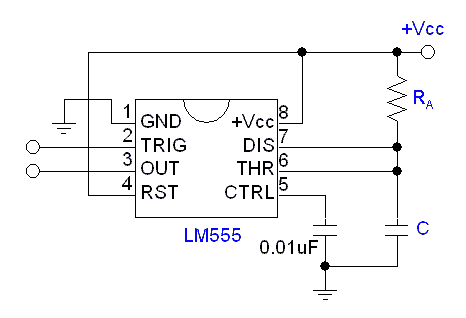Difference between revisions of "555 Timer"
| Line 23: | Line 23: | ||
[[Image:555_monostable.gif]] |
[[Image:555_monostable.gif]] |
||
The circuit operates as follows: |
|||
##In this circuit's initial condition, the capacitor ''C'' is held discharged through the ''discharge'' pin, which is grounded through the flip-flop in the timer. The ''threshold'' voltage is equal to the voltage acroll the capacitor. |
|||
##When the ''trigger'' pin receives a negative trigger pulse less than 1/3 V<sub>CC</sub>, the flip-flop sets the ''output'' to high and disconnects the ''discharge'' pin from the ground. This allows the capacitor to charge until the voltage across it reaches 2/3 V<sub>CC</sub>, which takes about 1.1R<sub>A</sub>C seconds. |
|||
##When the ''threshold'' voltage reaches 2/3 V<sub>CC</sub>, the flip-flop resets, connecting ''discharge'' to the ground and setting ''output'' to ''low''. It is now back in the initial state, and awaits another trigger pulse. |
|||
Revision as of 15:15, 3 July 2006
Connection digram for the 555 IC timer (click for larger image).
The output of a 555 timer is either high (close to +VCC) or low (close to GND).
Inside the 555 timer is a voltage divider the divides +VCC into thirds. A voltage comparator compares the trigger input (pin 2) with 1/3 VCC, and another comparator compares the threshold (pin 6) with 2/3 VCC. The point at 2/3 VCC on the voltage divider is connected to the control voltage (pin 5). This pin can be used to modify the values of 1/3 VCC and 2/3 VCC without having to change VCC. However, if this input is not going to be used, it should be connected to a bypass capacitor (0.01uF) to protect it from noise.
The 555 timer also has a flip-flop, which is controlled by the two comparators and the reset input.
The trigger and reset inputs are level-sensitive active low inputs. To activate the trigger, the voltage on the pin must be pulled down to under 1/3 VCC. To reset the timer, the voltage on the pin must be pulled under 0.4V. The reset input will override other inputs and set the output (pin 3) to low. If the reset input is not going to be used, it should be wired to VCC to prevent false signals.
In its initial state (assuming threshold is low and trigger is high), the 555 timer's internal flip-flop connects the discharge (pin 7) to the ground and sets the output to low. Each time the trigger voltage is pulled down under 1/3 VCC, the flip-flop will break the discharge pin's connection to ground, and set the output to high. It will hold this state until something (usually a capacitor) forces the threshold pin's voltage equal to 2/3 VCC, which will reset the flip-flop.
Monostable and Astable mode
The 555 family of timer chips can be used in either monostable mode or astable' mode. In the monostable or "one shot" mode, each time the 555 timer is triggered, the output will go high for a specified amount of time, then return to low and await another trigger signal. In the astable mode, the timer triggers itself periodically and becomes an oscillator, sending out a train of pulses.
Monostable Mode
Connections for the 555 timer in monostable mode:
The circuit operates as follows:
- In this circuit's initial condition, the capacitor C is held discharged through the discharge pin, which is grounded through the flip-flop in the timer. The threshold voltage is equal to the voltage acroll the capacitor.
- When the trigger pin receives a negative trigger pulse less than 1/3 VCC, the flip-flop sets the output to high and disconnects the discharge pin from the ground. This allows the capacitor to charge until the voltage across it reaches 2/3 VCC, which takes about 1.1RAC seconds.
- When the threshold voltage reaches 2/3 VCC, the flip-flop resets, connecting discharge to the ground and setting output to low. It is now back in the initial state, and awaits another trigger pulse.

